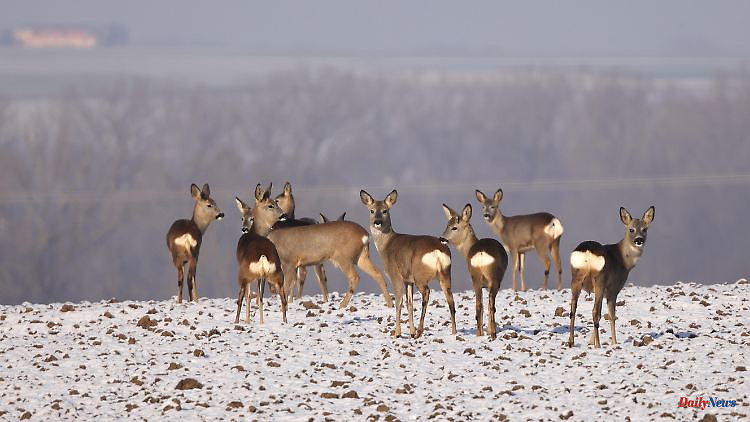Foresters and conservationists agree: more deer need to be shot. But the plan has drawn massive criticism. One reason is the Disney cartoon "Bambi", which flickered across the screen for the first time in 1942.
Big wide eyes, a happily bobbing tail and four stumpy legs - since "Bambi" many people have had a clear idea of the distribution of roles in the forest: on the one hand the cute, innocent deer, on the other hand the hunters, "Bambi's" mother kill. But now this picture is upside down: foresters and nature conservation organizations are calling for more deer to be shot, because they say they slow down the forest conversion that is so important in the climate crisis - but some hunters hesitate. A kind of culture war broke out around "Bambi".
The novel "Bambi - Eine Lebensgeschichte aus dem Wald" by the Austrian writer Felix Salten was published around 100 years ago, first as a serial story in a newspaper, then as a novel in an initial edition of 8000 copies at the end of 1922. The book was pre-dated to 1923 when it was published. However, "Bambi" only became famous in 1942 with the Disney cartoon based on the book. This was formative for generations of children - also for the Munich media scientist Maya Götz. "It shapes our image, how is a deer doing. And it shapes the image of the hunter - namely: he shoots deer."
In particular, the scene in which "Bambi's" mother is shot during a hunt still has an impact decades later, as Götz found out in a study on fear and nightmares that films evoke. To do this, she asked around 630 adults from eight countries about their earliest fear experiences. ""Bambi" was one of the most frequently mentioned films," says the expert from the International Central Institute for Youth and Educational Television of the Bavarian Broadcasting Corporation. The death of "Bambi's" mother is so disturbing because preschool children cannot distance themselves from the content. "They're Bambi at that moment. It's a traumatic experience for them that gave them nightmares."
It is also difficult to argue against the power of images. "Bambi" is still a "supergau for forestry," says the Bavarian local caretaker Rudolf Neumaier, who himself wrote a book about the fascination of deer. "The wild animal deer has become so popular through the Bambi brand that it's difficult to tell a story where it's a vermin." Neumaier is a hunter himself and therefore observes the debate about the number of kills very closely. "It's a huge topic at the moment," he says. "I think it's too quick to demand that the deer stocks be adjusted - or regulated, as it is euphemistically called."
Ralf Straußberger from the Bavarian Nature Conservation Union is one of those who is calling for this. "Of course, the deer are not to blame for the development. This is man-made," he says. The cause is a "completely misguided hunting and forestry policy". According to the Federal Ministry of Agriculture, around 450,000 hectares of forest will have to be reforested in Germany in the next few years after severe storms, extreme drought and bark beetle infestation. But often the young trees don't have a chance to grow up because deer and deer nibble on them, says Straußberger. "You lose central tree species." Because especially climate-resistant species such as oak or fir are popular with wild animals.
Nobody can say how many deer there are in Germany. According to Straußberger, however, their number is completely underestimated. Because deer have hardly any natural enemies, find food in fields all year round and are sometimes even fed in winter, they could multiply rapidly, he says. Above all in areas where the forest is damaged, the shooting quotas must therefore increase. He himself is a hunter and is involved in what he says is the largest forest conversion project in Bavaria south of Nuremberg. He and his colleagues shoot 10 to 15 deer per 100 hectares there every year. "You have to adapt that locally," he says.
The fact that such a demand is met with a lack of understanding is also due to "Bambi," says Straussberger. "Many believe because of the film that the deer is the male deer. It shows how a story can give a completely wrong impression," explains the conservationist. In Salten's novel, "Bambi" is a roebuck. In the film, which takes place in North America, it becomes a white-tailed deer.
The forest scientist Ulrich Schraml taught wildlife management for years and used "Bambi" to discuss with his students how everyday culture can affect management tasks. But he hasn't shown the film lately because young people didn't see it when they were children, says the director of the Baden-Württemberg Forestry Research Institute in Freiburg. "That's why the effect is no longer as great as it is said to be." Nevertheless, he still sees a special relationship with deer and deer in Germany. "There is a completely different discussion about the shooting than about the wild boar."
The reason is cultural-historical: in fairy tales, legends, paintings and even decorative items - deer and deer are encountered everywhere as an inspiring figure. From an ecological point of view, however, according to Schraml, it can make sense to hunt more deer. In many forests, these are responsible for the fact that certain trees cannot grow tall because, in contrast to red, fallow and sika deer, deer are found everywhere. In addition, roe deer have relatively small stomachs and are therefore dependent on high-quality food. "That's why deer are more interested in going from bud to bud because that's where the nutrients are concentrated," explains Schraml. "You have to put pressure on by hunting where you are converting the forest."
According to the German Hunting Association, 1.2 million deer are shot in Germany every year. According to spokesman Torsten Reinwald, the debate on how many more there should be to protect the forest falls short. "You need wild ecological spatial planning." In addition to increased hunting in reforested areas, this also means, for example, quiet zones with an attractive supply of food. Like Disney's feel-good world, the demonization of deer has little to do with nature, he says. "That's another extreme that doesn't do justice to reality. Ultimately, the deer is just one forest dweller among many."
Andreas Kinser from the German Wildlife Foundation in Hamburg takes a similar view. "You get too attached to one factor. The deer don't prevent forest regeneration, it just delays it." In areas where storms or the bark beetle have raged, hunting plays an important role, but is not the only solution. Newly planted trees from the tree nursery, such as Douglas fir or red oak, would need additional protection in the first few years. Because these are a treat for deer with their high nutrient content.
"I'm not sure if "Bambi" didn't do more damage to the deer," says Kinser, referring to the debate about the numbers killed. "Without the cliché, there wouldn't be as much emotionality in the debate. That doesn't make it any easier."












